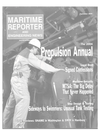
ABS: Large Ship Hull Deflections Impact the Shaft Alignment
A report issued earlier this year from ABS indicates that larger ships, driven by the latest generation of very highpowered diesel engines, are particularly susceptible to alignment problems on the bearings supporting the propulsion shafting as well as the main engine bearings.
Hull girder deflection is one of the major reasons for the increased number of propulsion shafting and the main engine bearing failures and damages that are being reported. Hull deflections are quite pronounced on large vessels where discrepancy between the flexibility of the hull and the shafting results in high sensitivity in the alignment dependent upon the vessel's loading condition.
Responding to industry need, ABS has investigated the hull deflections effect on the shaft alignment, conducting measurements on a large number of vessels and using the information to develop a state of the art alignment optimization software. ABS has also released Guidance Notes on Propulsion Shafting Alignment to provide detailed information on propulsion shafting alignment design procedure and to improve the design review process and survey.
ABS research indicates that the alignment related damages are mostly attributable to inadequate analysis and design of the alignment, inadequate construction practices and lack of proper guidance.
Ship hull structures have become more flexible with scantling optimization and with an increase in ship's length. As the powering requirements increased with the increase in the ship's size, shafting diameters become larger and the shafts stiffen This is particularly true for VLCCs, ULCCs, large bulk carriers and containerships. As a result, the propulsion shafting alignments are increasingly more sensitive to disturbances affecting vertical offset of the bearings. These disturbances primarily result from hull deflections and temperature change.
As the alignment analysis is the first step in the alignment process, it is of paramount importance to clearly define the criteria and determine a robust alignment that will have a sufficiently low sensitivity to disturbances affecting the propulsion shafting and the main drive.
Accounting for hull girder deflections is one of the most important issues in that process. However, hull deflections are not of constant magnitude, but rather a function of different vessel loading conditions as well as the sea conditions affecting the vessel on passage. To define satisfactory alignment for all expected operating conditions, design engineers need to optimize the bearing offset to satisfy all expected disturbances.
Advanced knowledge of hull deflections is of critical importance in this process. ABS conducts hull deflection measurements to obtain information on expected behaviors of the hull structure under different sea conditions and inputs the data into the shaft alignment optimization software.
End Note: A free downloadable copy of the ABS Guidance Notes on Propulsion Shafting Alignment is available from the ABS web site at: http://www. eagle, org/rules/down - loads/128-ShaftAlign.pdf
Other stories from September 2004 issue
Content
- SSI Concerns Continue page: 5
- Signed Confessions page: 9
- OMI to Pay $4.2M for Waste Oil Dumping page: 14
- NASSCO Delivers Alaskan Frontier page: 17
- Alabama Shipyard to Build Hopper Dredge page: 17
- Merwede Tapped for Navy, Commercial Contracts page: 18
- FBM Babcock Wins U.S. Contract page: 19
- New Vessels from VT Halmatic page: 19
- ABCO Launches Three New Boats page: 20
- IR Generates $64M in Orders page: 24
- Sideways to Swimmers: Unusual Tank Testing page: 26
- Current Uses of FEA in Shipbuilding page: 30
- BMT Aims to Improve Vessel Evac page: 32
- Flensburg Makes its Mark Again page: 36
- SMM 2004: Ready for the World page: 36
- German Shipyards Propose Merger page: 37
- Voith to Exhibit VWT Baut at SIMM page: 37
- Blohm + Voss Repair Wins Business page: 38
- Methane Arctic Benefits from German Technology page: 39
- Becker Kort Rudder Nozzles for Improved Maneuverability page: 40
- Payer Presented Cross of the Order of Merit page: 42
- Xantic: Focus on Integrated Solutions page: 44
- A Benchmark in Electronic Fuel Injection page: 45
- Q&A with Wartsila CTO Matti Kleimola page: 46
- Seacor Crewboats "Eliminators" Some Maintenance Costs page: 49
- (Fuel) Cells of Endeavor page: 50
- Containerships: When Will One Engine Not Be Enough? page: 52
- Most Powerful Common- Rail Engine Passes Test page: 54
- Clean Concept for Brostrom Tankers page: 54
- Canadian Towing Firm Refits for the Future page: 56
- TOR: The Next-Generation Turbocharger page: 57
- Duramax Marine Creates Largest Ever DuraCooler page: 58
- ABS: Large Ship Hull Deflections Impact the Shaft Alignment page: 60
- The Great Maritime Disruption... that Never Happened page: 66
- New Positioning Technique Helps Cut Costs in Deepwater GOM page: 76
- U.S. Ferry Market Prospects Looking Up page: 77
- "Ship Design and Construction" page: 81

